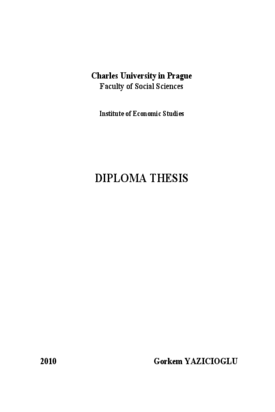An analysis on US subprime mortgage crisis : expansion and the burst of bubble
diplomová práce (OBHÁJENO)

Zobrazit/
Trvalý odkaz
http://hdl.handle.net/20.500.11956/26890Identifikátory
SIS: 102582
Kolekce
- Kvalifikační práce [18432]
Autor
Vedoucí práce
Oponent práce
Cahlík, Tomáš
Fakulta / součást
Fakulta sociálních věd
Obor
Ekonomie a finance
Katedra / ústav / klinika
Institut ekonomických studií
Datum obhajoby
23. 6. 2010
Nakladatel
Univerzita Karlova, Fakulta sociálních vědJazyk
Angličtina
Známka
Výborně
This thesis provides an analysis on the expansion and the burst phases of the 2007 subprime mortgage bubble, in two interrelated sections. The first part - called "Expansion of the bubble"-, analyzes the speculative investor behaviour of the US Real Estate Crisis and exhibits that before the crisis the asset prices such as Commercial Mortgage Backed Securities and Standard and Poor's 500 indexes showed statistical features which are not common among financial time series. Common stylized facts such volatility clustering and autocorrelation of absolute returns were tested for the years 1997-2010, using daily data on the index values. The results indicate that during bubble periods several of the stylized facts disappeared since investors did not respond as normal to the volatility events and price changes. Hence, I have suggested that irrational exuberance of investors during 2007 subprime mortgage crisis and other bubble periods can be detected by testing these stylized facts. In the second part,- called "The burst of Bubble" -, I showed that common macroeconomic risk factors can explain, to a very large extent, all types of mortgage's credit risk and I concluded that individual mortgages are possessing significant default correlation, especially subprime mortgage classes. Finally this thesis ends with...
This thesis provides an analysis on the expansion and the burst phases of the 2007 subprime mortgage bubble, in two interrelated sections. The first part - called "Expansion of the bubble"-, analyzes the speculative investor behaviour of the US Real Estate Crisis and exhibits that before the crisis the asset prices such as Commercial Mortgage Backed Securities and Standard and Poor's 500 indexes showed statistical features which are not common among financial time series. Common stylized facts such volatility clustering and autocorrelation of absolute returns were tested for the years 1997-2010, using daily data on the index values. The results indicate that during bubble periods several of the stylized facts disappeared since investors did not respond as normal to the volatility events and price changes. Hence, I have suggested that irrational exuberance of investors during 2007 subprime mortgage crisis and other bubble periods can be detected by testing these stylized facts. In the second part,- called "The burst of Bubble" -, I showed that common macroeconomic risk factors can explain, to a very large extent, all types of mortgage's credit risk and I concluded that individual mortgages are possessing significant default correlation, especially subprime mortgage classes. Finally this thesis ends with...
